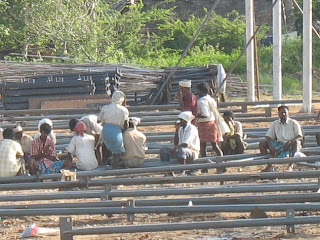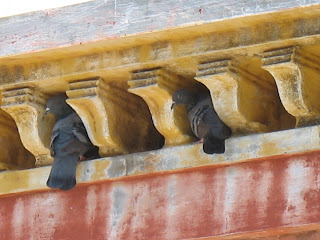The following report is about Dalits gaining entry into a Temple in Tiruvannamalai District. Seems difficult to believe that this is truly the year 2007!
Express News Service
Tiruvannamalai, Oct 4:
The Thirugnaneeshwarar Temple in Thamaraipakkam Village here was forcibly rid of its age-old practice of denying entry to the so-called ‘untouchables’ when, on Thursday, a group of Dalits from the village successfully entered the Shiva Temple and offered prayers.
According to people of the village, the Temple, situated on the banks of the Cheyyar River, is more than 1,000 years old. The Dalit population of the village has been denied entry to the Temple since time immemorial. The Communist Party of India (Marxist) had even taken up the issue and represented it to the officials concerned for remedy. In fact, the party had also decided to enter the Temple along with Dalits on Thursday if caste Hindus of the Village stuck to their stand of not allowing them into the Temple.
Sivakumar, District President of the Tamil Nadu Agricultural Labourers’ Association, who was among those who participated in the Temple entry said, “I first came across the Dalit issues when, sometime ago, I saw in a small hotel in the village idlis being packed in bare newspaper without using a plastic sheet or banana left for Dalit customers alone. Later, I came to know about the discrimination in the Temple”.
After gaining entry in the to the Temple, the agitating Dalits went to one of the tea shops where the ‘two-tumbler’ system was allegedly in practice. The shopkeeper broke the tradition and served them tea in the same type of cups used for other people in the village.
**********
In the Indian caste system, a Dalit, often called an untouchable, or an outcaste, is a person who according to traditional Hindu belief does not have any "Varnas". Varna refers to the Hindu belief that most humans were supposedly created from different parts of the body of the divinity Purusha. The part from which a varna was supposedly created defines a person's social status with regards to issues such as who they can marry and which professions they could hold. Dalits fall outside the varna system and have historically been prevented from doing any but the most menial jobs. (However, a distinction must be made between lower-cast people and Pariahs.) Included are leather-workers (called chamar), poor farmers and landless labourers, night soil scavengers (called bhangi or chura), street handicrafters, folk artists, street cleaners, dhobis etc. Traditionally, they were treated as pariahs in South Asian society and isolated in their own communities, to the point that even their shadows were avoided by the upper castes.
Discrimination against Dalits still exists in rural areas in the private sphere, in ritual matters such as access to eating places and water sources. It has largely disappeared, however, in urban areas and in the public sphere, in rights of movement and access to schools. The earliest rejection of discrimination, at least in spiritual matters, was made as far back as the Bhagavad Gita, which says that no person, no matter what, is barred from enlightenment.
To read more of this information on Dalits please click here.
 Three brothers (left to right; Casper, Oscar, Wally) with matching jaunty, genetically flawed left floppy ears, that make them look like they have just returned from a night on the town. The little princess (green collar) in the front, is Holly.
Three brothers (left to right; Casper, Oscar, Wally) with matching jaunty, genetically flawed left floppy ears, that make them look like they have just returned from a night on the town. The little princess (green collar) in the front, is Holly.












































